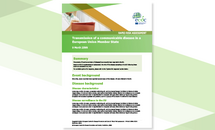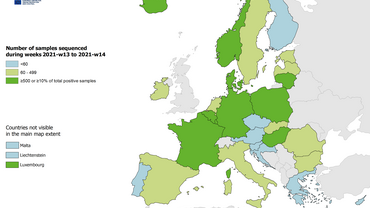Assessment of the further emergence of the SARS-CoV-2 Omicron VOC in the context of the ongoing Delta VOC transmission in the EU/EEA, 18th update
The risk to public health posed by the spread of the Omicron VOC in the context of ongoing Delta VOC transmission in the EU/EEA is assessed in this update. The Delta VOC remains the most prevalent variant, but community-associated spread of the Omicron VOC is occurring in the EU/EEA and the Omicron VOC will probably become dominant in early 2022, based on mathematical modelling predictions. We therefore assess the probability of further spread of the Omicron variant in the EU/EEA as VERY HIGH.
Executive summary
Emergence of the Omicron variant of concern (VOC) raises serious concerns due to preliminary reports of a significant growth advantage and potential immune escape compared to the Delta variant. Although the Omicron VOC cases initially reported in the EU/EEA were linked to travel, an increasing number of cases are now recorded as having been acquired within the EU/EEA, including as parts of clusters and outbreaks. Cases are also being detected through representative sampling in routine surveillance systems. This indicates that community transmission is already ongoing in EU/EEA countries and that further rapid increase in the number of Omicron VOC cases is expected in the next two months.
The overall epidemiological situation in the EU/EEA is still characterised by a high case notification rate and a low, but slowly increasing death rate, driven by the ongoing transmission of the Delta VOC. The Delta VOC remains currently the most prevalent variant. However, based on modelling predictions, and depending on the growth advantage and level of immune escape, the Omicron VOC is likely to become the dominant variant in the EU/EEA within the first two months of 2022. Data are currently too limited to assess the severity of disease caused by the Omicron VOC in the EU/EEA population with sufficient confidence. However, even if the severity of disease caused by the Omicron VOC is equal to or lower than the severity of the Delta VOC, the increased transmissibility and resulting exponential growth of cases will rapidly outweigh any benefits of a potentially reduced severity. It is therefore considered very likely that the Omicron VOC will cause additional hospitalisations and fatalities, in addition to those already expected in previous forecasts that only take into account the Delta VOC.
Effectiveness of vaccines against severe outcomes caused by the Delta VOC remains high. As of 9 December 2021, the cumulative full COVID-19 vaccine uptake in the total population of the EU/EEA is 66.8%. A slow increase in vaccine uptake has been reported in recent weeks and in the adult population the administration of booster doses, as a supplement to the full primary course, has been accelerating. Overall, progress in uptake remains uneven across countries, with four EU/EEA countries still reporting less than 50% full vaccine uptake in their total populations. Early evidence from in vitro neutralisation studies, not yet peer-reviewed, shows a reduced neutralisation capacity of sera from vaccine recipients and convalescent sera against the Omicron VOC compared to other SARS-CoV-2 variants, although large uncertainties persist. In addition, there is still insufficient real-life data on the effectiveness of the vaccines authorised in the EU against the Omicron VOC. According to the evidence currently available, for severe outcomes caused by the Delta VOC and potentially the Omicron VOC, booster doses will increase protection, with the population impact expected to be higher if the booster dose is given to most of the adult population within a short interval. Data currently available support safe and effective administration of a booster dose as early as three months from completion of the primary vaccination. Shortening the administration interval to three months may require adaptation of national vaccine deployment plans.
The mathematical modelling results, presented in detail below, demonstrate that strong and immediate reductions in contact rates are also required to avoid a high spike in cases caused by the Omicron VOC and to keep the COVID-19-related health and mortality burden manageable in the short term, even with an immediate acceleration of vaccine roll-out. In response to high incidence of the Delta VOC, non-pharmaceutical interventions (NPIs) should continue to be implemented by all countries and given the impending probable dominance of the Omicron VOC, these need to be further strengthened without delay. The immediate reinforcement of NPIs will slow the spread of the Omicron VOC, to allow countries to gain time for further vaccination roll-out, including booster doses, and to prevent a sudden high impact from the spread of this variant. Without reduction of contact rates through the implementation of NPIs and increased booster vaccination, levels of transmission could rapidly overwhelm EU/EEA healthcare systems.
Risk assessed
The risk to public health posed by the spread of the Omicron VOC in the context of ongoing Delta VOC transmission in the EU/EEA is assessed in this update. The Delta VOC remains the most prevalent variant, but community-associated spread of the Omicron VOC is occurring in the EU/EEA and the Omicron VOC will probably become dominant in early 2022, based on mathematical modelling predictions. We therefore assess the probability of further spread of the Omicron variant in the EU/EEA as VERY HIGH.
Although current data on the severity of the infection associated with the Omicron VOC remain limited, evidence to date raises concern that the Omicron VOC may be associated with a significant reduction in vaccine effectiveness against SARS-CoV-2 infection. Even in the case of lower infection/disease severity with the Omicron VOC, a steep, exponential increase in cases caused by the Omicron VOC will result in a growing number of cases with severe disease. As EU/EEA countries are still facing the severe impact of the Delta VOC wave, a further rise in hospitalisations could quickly overwhelm healthcare systems. We therefore assess the impact of the spread of the Omicron VOC as VERY HIGH.
Based on the limited evidence currently available, and given the high level of uncertainty, the overall level of risk to public health associated with the further emergence and spread of the SARS-CoV-2 Omicron VOC in the EU/EEA is assessed as VERY HIGH.
Options for response
Urgent and strong action is needed to reduce transmission in order to alleviate the already heavy burden on healthcare systems and protect the most vulnerable in the coming months.
Rapid reintroduction and strengthening of NPIs is necessary to reduce the ongoing Delta VOC transmission, slow down the spread of the Omicron VOC and keep the COVID-19-related healthcare and disease burden manageable. These measures include avoiding large public or private gatherings, encouraging the use of face masks, reduced contacts between groups of individuals in social or work settings, teleworking, expanded testing and strong contact tracing. Authorities should consider advising reduced inter-household mixing and exercising additional caution during travel and/or where intergenerational mixing is foreseen during the holiday season. While the proportion of Omicron VOC cases remains low and resource capacity allows, contact tracing should be prioritised for probable or confirmed cases of Omicron VOC infection, irrespective of vaccination status, in a timely manner and as completely as possible.
Vaccination remains a key component of the multi-layered approach needed to reduce the impact of the Omicron VOC, while also addressing the ongoing circulation of the Delta VOC. Efforts should continue to increase full vaccination uptake in individuals who are currently unvaccinated or partially vaccinated. Booster doses will increase protection against severe outcomes from the Delta VOC, and preliminary evaluations also suggest boosters could increase protection against the Omicron VOC. The population impact is expected to be higher if a booster dose is administered to most of the adult population and if this booster dose is given as early as possible, although not before three months after completion of the full vaccination course.
Immediate planning should be considered to increase healthcare capacity to treat the expected higher number of cases. Hospital surge capacities should be re-assessed according to emerging epidemiological data on the severity of the Omicron VOC.
Testing of individuals with symptoms, irrespective of their vaccination status, together with isolation of those testing positive, continues to be important in limiting the spread of SARS-CoV-2. Testing strategies should be flexible and rapidly adaptable to the epidemiological situation and available resources. Genomic surveillance remains of utmost importance for early detection of the presence of the Omicron VOC, to enable the monitoring of epidemiological trends and to guide measures.
Risk communication activities remain vital and these should emphasise the continued importance of being fully vaccinated and seeking an additional or booster vaccine dose. Messaging should continue to stress the importance of continued adherence to NPIs. Countries should consider investing in social listening activities to rapidly identify and address misinformation.
In order to address knowledge gaps in the context of the emerging Omicron VOC, it is critical to report data to ECDC and WHO and to monitor vaccine effectiveness. ECDC has proposed a generic protocol to guide vaccine effectiveness studies and foresees the possibility of voluntary reporting of outbreak data in EpiPulse.
What is new in this assessment?
This Rapid Risk Assessment extends the assessment on the circulation of the Delta VOC and projections for the festive period that was published on 24 November 2021 to include the emergence and spread of the Omicron VOC. The updated forecasts developed for this risk assessment are informed by the latest evidence on Omicron VOC epidemiology, transmissibility, severity, and immune escape.







